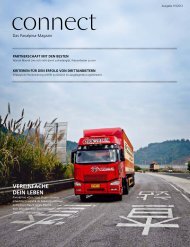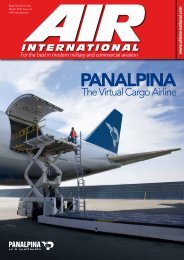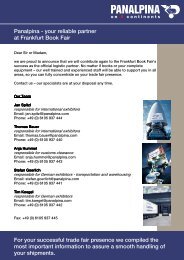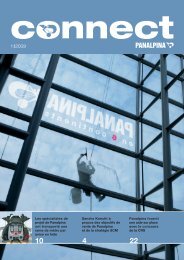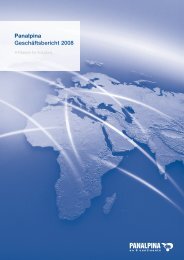Panalpina Annual Report 2006
Panalpina Annual Report 2006
Panalpina Annual Report 2006
Create successful ePaper yourself
Turn your PDF publications into a flip-book with our unique Google optimized e-Paper software.
<strong>Report</strong> of the Executive Board<br />
16 <strong>Panalpina</strong> <strong>Annual</strong> <strong>Report</strong> <strong>2006</strong><br />
Quarterly development of the core activities<br />
Air freight Ocean freight Supply chain management<br />
in million CHF<br />
2,250<br />
2,000<br />
1,750<br />
1,500<br />
1,250<br />
1,000<br />
750<br />
500<br />
250<br />
248<br />
535<br />
734<br />
315<br />
675<br />
844<br />
Q1/05<br />
Q1/06<br />
Air freight review<br />
271<br />
593<br />
810<br />
292<br />
679<br />
887<br />
Q2/05<br />
Q2/06<br />
According to statistics gathered by IATA, International<br />
Air Transport Association, the international<br />
freight tonnages grew by 4.6% in FTKs (freight<br />
ton kilometers measuring the actual freight traffic).<br />
This is still below the trends seen in the past of<br />
5.6% in average, but better than in 2005, where<br />
the air freight market growth was 3.2%.<br />
Industry sources have attributed the continued<br />
downturn in freight tonnages to high oil prices that<br />
are dampening economic activity.<br />
The air freight activity in <strong>2006</strong> for the Group can<br />
be summarized as follows:<br />
• Tonnages grew 10.5% reaching 874,000 tons.<br />
This outgrowing of the market was fueled<br />
by the gaining of new accounts as well as by<br />
the increase of existing business favored by<br />
the positive trend of the world economy in <strong>2006</strong>.<br />
• Fuel and security surcharges were still inflating<br />
the net forwarding revenues, remaining at high<br />
levels during the better part of the year.<br />
Tonnages on westbound traffics, namely Asia –<br />
Europe, and eastbound Asia – North America<br />
remained buoyant and grew at rates well above the<br />
average growth rate experienced in the market.<br />
Tonnage growth on eastbound traffics from Europe<br />
to the Far East and Asia were still suffering from<br />
overcapacity and a downtrend in prices to customers.<br />
Overall, the tonnages flown on the lane<br />
Emea – Asia – Emea experienced an increase of over<br />
19.5%. This remains the Group’s single most<br />
important trade lane comprising over 30% of total<br />
tonnage.<br />
Next to those rather traditional high volume<br />
trade lanes, in <strong>2006</strong> a new trend started to show<br />
and recorded impressive growth rates: Asia – Latin<br />
America has increased more than 20% compared<br />
to previous year.<br />
283<br />
625<br />
859<br />
315<br />
717<br />
912<br />
Q3/05<br />
Q3/06<br />
340<br />
646<br />
1,005<br />
274<br />
755<br />
1,070<br />
Q4/05<br />
Q4/06<br />
In summary, air freight tonnages grew at a much<br />
higher pace than in 2005 with continued imbalances<br />
on the different trade lanes and fierce competition<br />
to secure capacity during high season:<br />
price pressure both from airlines and customers<br />
is omnipresent.<br />
Ocean freight review<br />
Recording an impressive revenue growth of 17.8%<br />
over previous year, ocean freight was the front<br />
running core activity in <strong>2006</strong>. The reasons thereof<br />
are enumerated below:<br />
• 17.4% volume increase outpaced market growth<br />
of 10.7% (Clarkson, January 2007). The absolute<br />
figure rose from 922,880 TEU in 2005 to exceed<br />
the million TEU with 1,084,000.<br />
For the first time since many years, the supply in<br />
containerized capacity substantially outpaced<br />
the demand, having a compressing effect on the<br />
level of the ocean freight buying rates.<br />
The Europe – Far East eastbound / westbound<br />
trade lanes are the Group’s strongest trade lanes,<br />
comprising over 35% of ocean freight volumes,<br />
followed by the Transpacific eastbound /westbound<br />
trade lane, which comprised 17%, and<br />
the Transatlantic eastbound/westbound, which<br />
comprised 16%.<br />
In ocean freight, the same scenario as in air freight<br />
could be observed: one of the most significant<br />
growth rates was recorded on the Asia – Latam<br />
southbound lane growing by 47%.<br />
• The net forwarding revenue of the first quarter<br />
<strong>2006</strong> ended even higher than the highest quarter<br />
of 2005, announcing a record year. The revenue<br />
growth was affected by both, a considerable<br />
increase in volume and a growing imbalance of<br />
supply and demand for capacity on the market.<br />
This granted the industry and consequently<br />
<strong>Panalpina</strong> further rate decline on the major East /<br />
West trades.<br />
In a contrast, the capacity supply for bulk vessels,<br />
necessary for the Group’s special project business,<br />
was not exceeding demand in the same way<br />
as the container ships capacity. Consequently<br />
the freight rates of this sector increased during<br />
<strong>2006</strong>, contributing to higher net forwarding<br />
revenues, the project business accounting for<br />
5% of the total Group’s revenues.<br />
The Bunker Adjustment Factor (BAF), corresponding<br />
to the fuel surcharge for ocean freight,<br />
remained at very high levels during the majority<br />
of the year, slightly easing up during the last<br />
quarter. Nevertheless, the average BAF for <strong>2006</strong><br />
was higher than for the previous year. Management<br />
estimates its share on the net forwarding<br />
revenues increase over the previous year to be<br />
approximately 7%.<br />
• Continued pressure from customers.



![Eigenes Luftfrachtnetzwerk [pdf | 244 KB] - Panalpina](https://img.yumpu.com/23347328/1/184x260/eigenes-luftfrachtnetzwerk-pdf-244-kb-panalpina.jpg?quality=85)
![Übersicht Panalpina [pdf | 240 KB]](https://img.yumpu.com/22547731/1/184x260/ubersicht-panalpina-pdf-240-kb.jpg?quality=85)
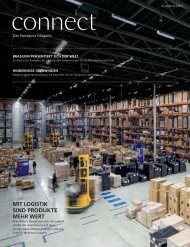
![Seefracht [pdf | 181 KB] - Panalpina](https://img.yumpu.com/22234724/1/184x260/seefracht-pdf-181-kb-panalpina.jpg?quality=85)


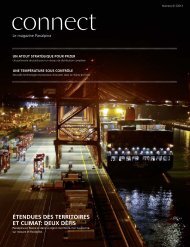
![Annual Report 2012 [pdf | 1 MB] - Panalpina](https://img.yumpu.com/15342099/1/184x260/annual-report-2012-pdf-1-mb-panalpina.jpg?quality=85)
